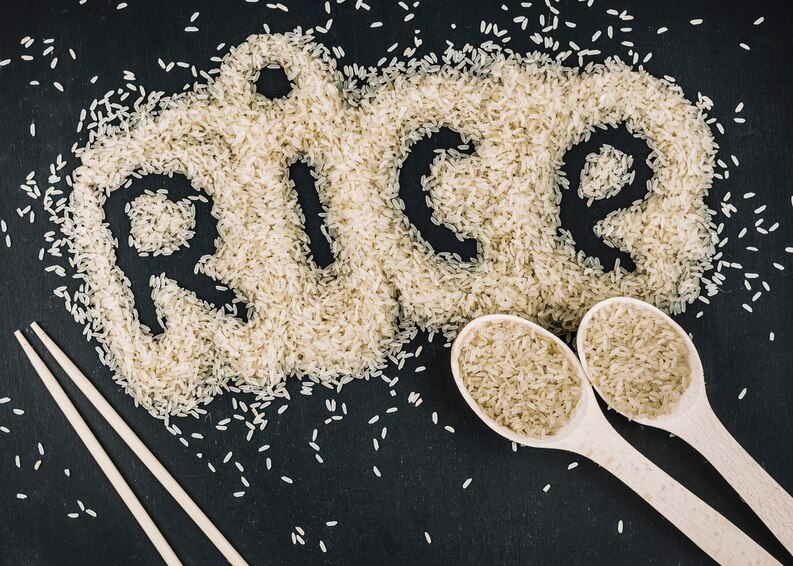Rice is a staple food for millions worldwide, providing sustenance and nourishment for various cultures. As a primary source of carbohydrates, rice has both ardent supporters and fervent critics. In this blog, we delve into the nutritional profile of rice, explore its impact on health, and uncover the truth behind the debate: Are carbohydrates in rice healthy or harmful?

Understanding Carbohydrates: The Body’s Energy Source
Before we dive into the rice debate, let’s grasp the significance of carbohydrates. They are the body’s primary source of energy, fueling essential bodily functions, physical activity, and brainpower.
Carbohydrates come in two forms:
1. Simple Carbohydrates:
Simple carbohydrates, also known as simple sugars, consist of one or two sugar units. of one or two sugar units, also called simple carbohydrates. They cause sudden rises in blood sugar because the body digests and absorbs them so quickly. Simple carbohydrates can be found in foods like glucose, fructose, lactose, and sucrose.
2. Complex Carbohydrates:
Complex carbohydrates, also known as polysaccharides, are composed of multiple sugar units arranged in long chains. Due to their intricate structure, they take longer to break down during digestion, resulting in a slower release of glucose into the bloodstream. Common sources of complex carbohydrates include Starch, Fiber.
Complex carbohydrates are often considered healthier choices compared to simple carbohydrates since they provide more sustained energy and are usually accompanied by essential nutrients like vitamins, minerals, and fiber. They help maintain stable blood sugar levels and contribute to a feeling of fullness, supporting overall health and weight management.
Rice mainly falls under the complex carbohydrate category, known for providing sustained energy release.
Rice Varieties: The Nutritional Distinctions
Not all rice is created equal. Let’s compare the two most popular varieties:
- White Rice: The refined version of rice, where the bran and germ are removed, leaving only the endosperm. White rice is notorious for its high glycemic index, causing rapid spikes in blood sugar levels.
- Brown Rice: Unlike white rice, brown rice retains its bran and germ, making it a whole grain. This variety is rich in fiber, vitamins, and minerals, offering a slower energy release and better blood sugar control.
This table compares the nutritional value of cooked 3.5 ounces (100 grammes) of several rice varieties.
| Nutrients | White rice, unenriched | White rice, enriched | Brown rice, unenriched |
| Calories | 123 | 123 | 111 |
| Protein | 2.9 grams | 2.9 grams | 2.6 grams |
| Carbs | 30 grams | 26 grams | 23 grams |
| Fat | 0.4 grams | 0.4 grams | 0.9 grams |
| Fiber | 0.9 grams | 0.9 grams | 1.8 grams |
| Folate | 1% of the RDI | 20% of the RDI | 1% of the RDI |
| Manganese | 18% of the RDI | 18% of the RDI | 45% of the RDI |
| Thiamine | 5% of the RDI | 14% of the RDI | 6% of the RDI |
| Selenium | 13% of the RDI | 13% of the RDI | 14% of the RDI |
| Niacin | 12% of the RDI | 12% of the RDI | 8% of the RDI |
| Iron | 1% of the RDI | 10% of the RDI | 2% of the RDI |
| Vitamin B6 | 8% of the RDI | 8% of the RDI | 7% of the RDI |
| Phosphorus | 6% of the RDI | 6% of the RDI | 8% of the RDI |
| Copper | 4% of the RDI | 4% of the RDI | 5% of the RDI |
| Magnesium | 2% of the RDI | 2% of the RDI | 11% of the RDI |
| Zinc | 2% of the RDI | 2% of the RDI | 4% of the RDI |
Source: Healthline
The Healthy Aspects of Carbohydrates in Rice
- Energy Boost: Carbohydrates are vital for athletes and individuals leading active lifestyles. Rice provides the necessary energy to enhance physical performance and aid in post-exercise recovery.
- Nutrient Profile: Brown rice, in particular, offers a wealth of nutrients such as B vitamins, magnesium, and selenium, supporting heart health and overall well-being.
- Digestive Health: The fiber in brown rice aids in digestion, prevents constipation, and fosters a healthy gut environment.
The Harmful Effects of Refined Carbohydrates
- Blood Sugar Spikes: Refined carbohydrates, as seen in white rice, can lead to sudden spikes in blood sugar levels. This can be detrimental to those with diabetes or insulin resistance.
- Empty Calories: Refined rice lacks essential nutrients present in brown rice, providing empty calories that offer little nutritional value.
Carbs in Rice: Is It Too Much?
Carbs in rice can be a concern for some, as it is a primary carbohydrate source. While rice provides essential energy, it’s crucial to consider portion sizes and opt for healthier varieties like brown rice or quinoa. Moderation is key, especially for individuals with specific health goals or conditions like diabetes. Balancing rice with protein and vegetables in meals can also help manage its impact on blood sugar levels. By being mindful of carb intake and making informed choices, rice can remain a delicious and nutritious part of a well-rounded diet.
Moderation is Key: Balanced Rice Consumption
Moderation and context are crucial rather than labeling rice as purely healthy or harmful. For individuals with active lifestyles, whole-grain rice, like brown rice, can be a valuable component of a balanced diet. On the other hand, those seeking weight loss or managing blood sugar levels might benefit from reducing white rice intake and opting for healthier grains like quinoa or barley.
The Right Way to Have Rice
A categorized approach can guide us toward making mindful choices when it comes to enjoying rice in a healthy and balanced manner. Let’s break it down:

Choose the Right Rice Variety:
Opt for healthier options like:
- Brown Rice: Rich in fiber, vitamins, and minerals, it offers sustained energy release and better blood sugar control.
- Wild Rice: A nutrient-dense alternative with a delightful nutty flavor.
- Quinoa: Although not rice, it’s a fantastic grain packed with protein and essential nutrients.
Mindful Cooking Methods:
Prepare rice using healthier cooking techniques such as:
- Steaming: Retains nutrients and natural flavors.
- Boiling: Requires less oil and preserves the grain’s nutritional value.
- Portion Control: Rice is calorie-dense, so be mindful of serving sizes to maintain a healthy weight.
Pairing Rice with Nutrient-Rich Foods
To enhance the nutritional value of your rice-based meals, consider adding:
- Protein: Combining rice with protein sources like beans, lentils, chicken, or tofu boosts the amino acid profile and supports muscle health.
- Vegetables: Incorporating colorful vegetables enhances the vitamin and mineral content, making your meal a nutritional powerhouse.
Final Words: Decoding the Carbohydrates in Rice
Carbohydrates in rice can be both healthy and harmful, depending on the variety and quantity consumed. Brown rice emerges as a nutritional champion, providing a wealth of nutrients and health benefits. White rice, while a significant energy source, should be consumed mindfully, especially for individuals with specific health concerns.
In the end, a balanced approach to rice consumption, paired with a diverse and nutrient-rich diet, holds the key to embracing the goodness of this grain while supporting overall health and well-being. So, let’s celebrate the cultural heritage of rice while making informed and mindful choices for our health.






